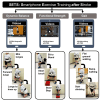Feasibility of Smartphone-Based Exercise Training Integrated with Functional Electrical Stimulation After Stroke (SETS): A Preliminary Study
- PMID: 40006483
- PMCID: PMC11861842
- DOI: 10.3390/s25041254
Feasibility of Smartphone-Based Exercise Training Integrated with Functional Electrical Stimulation After Stroke (SETS): A Preliminary Study
Abstract
One emerging method in home stroke rehabilitation is digital technology. However, existing approaches typically target one domain (e.g., upper limb). Moreover, existing interventions do not cater to older adults with stroke (OAwS), especially those with high motor impairment, who require adjunct therapeutic agents to independently perform challenging exercises. We examined the feasibility of Smartphone-based Exercise Training after Stroke (SETS) with Functional Electrical Stimulation (FES). A total of 12 participants (67 ± 5 years) with stroke (onset > 6 months) exhibiting moderate-to-high motor impairment (Chedoke McMaster Leg ≤ 4/7) underwent 6 weeks of multicomponent (gait, functional strength, dynamic balance) training integrated with FES to paretic lower limb muscles. Primary measures included safety and adherence. Secondary measures included motivation, acceptability and attitude, usability, and clinical measures of gait and balance function like the 10-Meter Walk Test and Mini-BESTest. Participants reported no adverse events and moderate-to-high adherence (84.17 ± 11.24%) and improvement (up to 40%) in motivation, acceptability, and attitude and system usability. Participants also showed pre-post improvements in all measures of gait and balance function (p < 0.05). Integrating SETS and FES is feasible and yields short-term gains in gait and balance function among OAwS. Future studies could validate our findings by examining its efficacy with control groups to identify the differential effects of SETS and FES.
Keywords: balance; digital technology; home; older adults; rehabilitation; strength; stroke; walking.
Conflict of interest statement
The authors declare no conflicts of interest.
Figures


Similar articles
-
Treadmill training with tilt sensor functional electrical stimulation for improving balance, gait, and muscle architecture of tibialis anterior of survivors with chronic stroke: A randomized controlled trial.Technol Health Care. 2015;23(4):443-52. doi: 10.3233/THC-150903. Technol Health Care. 2015. PMID: 25735313 Clinical Trial.
-
A single-center, assessor-blinded, randomized controlled clinical trial to test the safety and efficacy of a novel brain-computer interface controlled functional electrical stimulation (BCI-FES) intervention for gait rehabilitation in the chronic stroke population.BMC Neurol. 2024 Jun 13;24(1):200. doi: 10.1186/s12883-024-03710-3. BMC Neurol. 2024. PMID: 38872109 Free PMC article. Clinical Trial.
-
Treadmill gait training combined with functional electrical stimulation on hip abductor and ankle dorsiflexor muscles for chronic hemiparesis.Gait Posture. 2015 Jun;42(1):73-8. doi: 10.1016/j.gaitpost.2015.04.009. Epub 2015 Apr 25. Gait Posture. 2015. PMID: 26005188 Clinical Trial.
-
Functional electrical stimulation with exercises for standing balance and weight transfer in acute stroke patients: a feasibility randomized controlled trial.Neuromodulation. 2013 Mar-Apr;16(2):168-77. doi: 10.1111/j.1525-1403.2012.00488.x. Epub 2012 Aug 3. Neuromodulation. 2013. PMID: 22861816 Clinical Trial.
-
Implications of neuromuscular electrical stimulation on gait ability, balance and kinematic parameters after stroke: a systematic review and meta-analysis.J Neuroeng Rehabil. 2024 Sep 18;21(1):164. doi: 10.1186/s12984-024-01462-2. J Neuroeng Rehabil. 2024. PMID: 39294678 Free PMC article.
References
-
- Benjamin E.J., Virani S.S., Callaway C.W., Chamberlain A.M., Chang A.R., Cheng S., Chiuve S.E., Cushman M., Delling F.N., Deo R. Heart disease and stroke statistics—2018 update: A report from the American Heart Association. Circulation. 2018;137:e67–e492. - PubMed
MeSH terms
LinkOut - more resources
Full Text Sources
Medical
Miscellaneous

